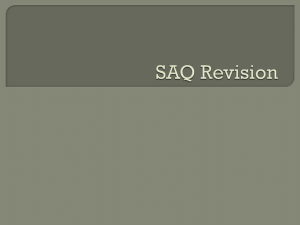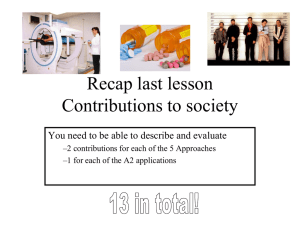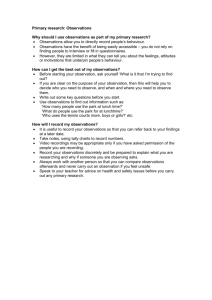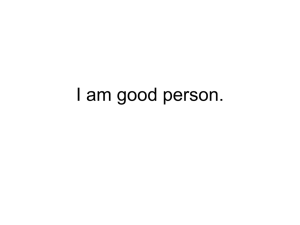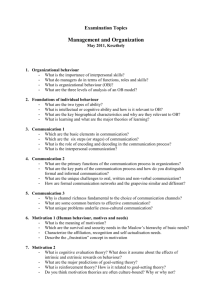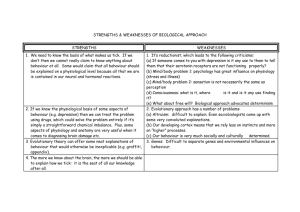The Social Sciences and Social Change: An
advertisement
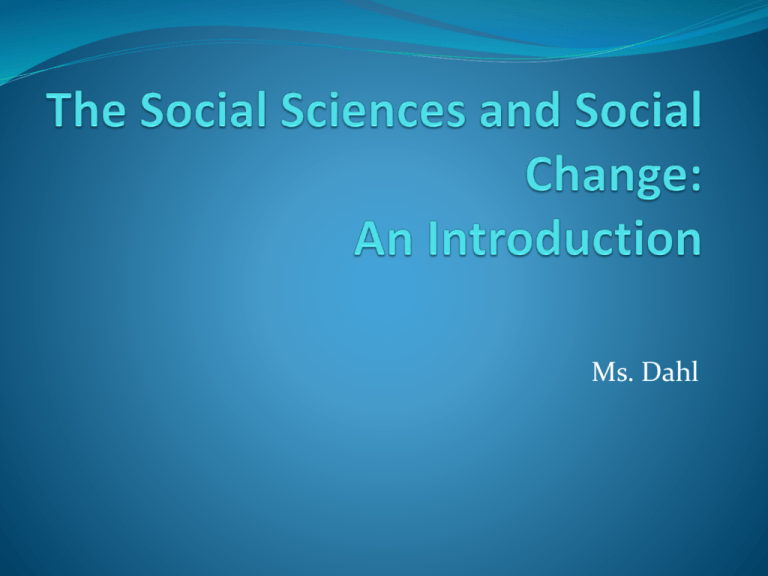
Ms. Dahl Social Change Social change can be defined as transformations in the beliefs, social interactions, practices, organization, and structure of society. We will be using the three social sciences of Anthropology, Sociology and Psychology to understand what causes social change, and the impact that it has on individuals and societies. Hmk: Read P. 10 – 19 in Challenge and Change and complete the organizer The Social Sciences and Social Change. The Social Science Inquiry Model Used to explore an issue or change in a disciplined way. 1. Develop a Research Question 2. Explore Alternative Perspectives 3. Formulate a Hypothesis 4. Collect Data 5. Assess the Hypothesis 6. Arrive at a Conclusion 7. Evaluate the Research *See page 4 in The Challenge of Change Flash Mobs and Robs Read pages 6 – 7 in The Challenge of Change Using the S.S.I.M., develop a strategy for learning more about the phenomenon of Flash Mobs and/or Flash Robs. In your table groups, write your research steps on chart paper. Be prepared to share your work with the class. Anthropology Psychology Sociology Anthropology (p.11 – 13) Definition/Areas of interest: The scientific study of humans, including their origins; behaviour; and physical, social and cultural development. Assumes that to understand human behaviour and social organization, we must look at our origins as a species. Broken into two broad categories: Physical Anthropology and Cultural Anthropology Research Methods Ethnology (the detailed, long term study of a culture) Field Research Participant Observation Statistical Analysis Analysis of ancient bones/artifacts Key Terms Culture Ethnology Participant observation Qualitative and Quantitative data Acculturation Diffusion Marvin Harris Bronislaw Malinowski Question: What are some examples of social change in Canada that has been influenced by acculturation? Diffusion? Schools of Thought - Anthro Cultural Materialism Infrastructure: the technological, economic, and demographic factors of a culture. Structure: how the culture is organized, such as political systems, laws and families. Superstructure: the ideology of a culture, its beliefs and values, such as religion or gender roles. Question: How can we describe the impact of the car on Canadian society using C.M.? (Hint: describe the car at each of the three levels) Schools of Thought - Anthro Functionalism The function of beliefs and institutions in a society is to meet the needs of the majority of its members Each part of society has a specific role that helps meet needs and maintain equilibrium (eg. Family brings in new members, Legal system makes and enforces rules, School prepares you for the workplace, etc.) Shared values and norms are passed on through generations maintaining some continuity in society Question: What is the role of poverty to a Functionalist? Read pages #12 -13 on Rites of Passage, Tattoos and Culture. Answer questions #1 – 3 in your notes. Discuss your answers with a partner. Psychology (p. 14) Definition/Areas of Interest: The study of the human mind, behaviours, emotions, cognitive processes and personality. Understands behaviour as both learned and innate. To understand why humans behave the way we do, we must understand the impacts of both the environment we grow up in (nurture), as well as our instincts, personality and mental processes (nature). Broken into two broad categories: Clinical and Experimental Methods of Research Interviews Case Studies Experiments Secondary Research Key terms Nature vs. Nurture Personality Behaviour Cognition Learning John Watson BF Skinner Sigmund Freud Schools of Thought: Psych Learning Theory Learning can alter the way an individual interprets the world around them and can lead to behavioural changes. Important to understand childhood as this is the time when most behaviour is learned If you understand what motivates behaviour, you can predict and control it Question: How has modern technology like the TV or internet impacted learning and behaviour? Bandura’s BoBo Doll Experiment The Bobo doll experiment was the collective name of the experiments conducted by Albert Bandura in 1961 and 1963. The goal was to study children's behaviour after watching an adult model act aggressively towards a Bobo doll. There are different variations of the experiment. The most notable experiment measured the children's behaviour after seeing the model get rewarded, punished or experience no consequence for beating up the bobo doll. http://www.youtube.com/watch?v=zerCK0lRjp8 This experiment is the empirical demonstration of Bandura's social learning theory . It shows that people not only learn by being rewarded or punished itself (behaviourism) they can learn from watching somebody being rewarded or punished, too (observational learning). These experiments are important because they sparked many more studies on the effects of observational learning and they have practical implication, e.g. how children can be influenced watching violent media. Schools of Thought - Psych Psychoanalysis Believes that there are 2 parts of the mind – the conscious and unconscious. The unconscious mind has a large impact on our behaviour, motivations and mental state. Human behaviour is determined by events in early childhood Question: Give an example of things (motivations, drives, experiences) that may reside in someone’s unconscious mind. How could it impact their behaviour? Sociology (p. 15 – 19) The study of society and social behaviour. Studies the interactions and conflicts within groups to determine how society functions. Norms, Values, Rules and Sanctions helps to organize society and maintain stability. Assumes that the group(s) that a person belongs to will determine the roles and expectations that they will value and emulate in their private lives. Question: How has social media changed the way that we relate in groups, and altered our roles, norms and values? Methods of Research Surveys Questionnaires Interviews Participant Observation Secondary Research Key Terms Roles Norms Values Sanctions Institutions Social organization Cognitive consistency/dissonance Microsociology Macrosociology Paradigm Shifts Confirmation Bias Dorothy Smith Karl Marx Emile Durkheim Talcott Parsons Max Weber Cognitive Dissonance Most people strive for cognitive consistency (avoiding attitudes that conflict with each other) When two attitudes conflict, we feel discomfort, which makes us want to change our attitudes to regain cognitive consistency This theory is called cognitive dissonance theory Example of C.D. Ex. Person X smokes, but also believes smoking causes cancer – these attitudes conflict and may lead them to avoid reading articles that discuss smoking and health. Person X has friends and relatives that nag them about quitting smoking all the time. After all the pestering, X feels guilty that they smoke and wants to fit in with their non-smoking friends. They start to thing about it, but haven’t decided whether or not to give quitting a try. There is some conflict and dissonance, but not enough to change. X has a relative that dies from cancer caused by smoking, this leads to increased conflict and dissonance, which may lead them to quit – a change in behaviour! Paradigm Shifts When a new set of ideals, beliefs and values become strong enough to affect and change the way individuals see and perceive reality. Question: What paradigm shifts have occurred in your lifetime? What caused them? Schools of Thought Structural Functionalism According to structural-functionalism, each society should provide its members with the fundamental requirements for functioning A system must have a way of fulfilling material needs, a system for socializing and educating the young, a way of regulating human reproduction (usually marriage) Structural-Functionalists believe their role is to try to explain the role of society’s systems in enabling human society to function Structural-Functionalists do not concern themselves with change but instead with how society works to meet their needs Schools of Thought Marxism Marx believed that economic power led to political power. This is the key to understanding societies The struggle for economic power means that society is not static but ever-changing – social change is the result of a change made to the economic system Therefore, if we want to understand society, we must understand the economic system in place and which groups have access to power Marxists believe the economic system creates a rich class of owners and a poor class of workers They also believe that social institutions (churches, schools, prisons etc.) have been created to perpetuate the division between the powerful and the powerless Schools of Thought Feminism Patterns of social inequality are based on gender. Feminist Theorists focus on sex and gender issues, believing that women have traditionally been disadvantaged in society because men have discriminated against them They believe that men have made the decisions in society and that they tend to favour men. Closely related to Marxism Schools of Thought Symbolic Interactionism Believe humans have complex brains and little instinctive behaviour This means they can interpret for themselves the stimuli they receive in their daily life and attach their own meanings to them Eg. One person might pursue fame and fortune while a sibling might dedicate his or her life to charitable work in a developing country It is essentially how we as individuals process and interpret what we observe in society, not society’s institutions, that form the core of our value system For this reason, Symbolic Interactionists focus their research on the human mind rather than on structures in society Activity Re-read the article on Flash Mobs and Flash Robs on page 6-7. How would each of the social sciences explain flash mobs and flash robs? Use the following headings to help you organize your notes: Key Assumptions (if an anthropologist/psychologist/ sociologist were to look at this situation, they would assume…) Possible Research Methods (if they wanted to find out more about the issue they would…) Explanation (they would likely say that flash mobs/robs are a result of…) Understanding Social Change Read the section about Malcolm Gladwell’s “The Tipping Point” on pages 8 – 9. In your notes, answer questions 2 – 3 from page 9. Share your answers with a partner/the class. Read p. 22 “Change in Action: Arab Spring” and watch the following video about the Egyptian Revolution. http://www.ted.com/talks/wael_ghonim_inside_the_e gyptian_revolution.html Use Gladwell’s theory to explain how the revolution in Egypt took place. Use the graphic organizer provided.
